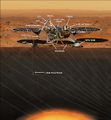Search results
Create the page "Planets" on this wiki! See also the search results found.

File:PIA17358-MarsInSightLander-20140326.jpg ...ientists better understand the evolution of our inner solar system's rocky planets, including Earth.(556 × 600 (76 KB)) - 18:41, 8 October 2018- ...mance in 1918. According to Prof. Robert Greenberg, “Each movement in The Planets represents the embodiment of the titled astrological character and then pro8 KB (1,296 words) - 18:12, 10 November 2020
- ...ticle, interplanetary commerce includes moons like [[Moon|Luna]] and dwarf planets like [[Ceres]]. Distances between the planets and Luna are always changing, requiring precise calculations for accurate t9 KB (1,398 words) - 14:52, 2 October 2020
- ...orites|meteoritic]] impact and erosion that forms the uppermost surface of planets, satellites and asteroids. It is a possible construction material in the fo4 KB (521 words) - 08:50, 4 November 2020
- ...Sarzi-Amade - ''Physical and orbit properties of the sun, earth, moon, and planets'' in J.R. Wertz, D.F. Everett & J.J. Puschell eds. ''Space mission engineer4 KB (588 words) - 07:53, 27 August 2021
- ...(SGG) are hundreds or thousands of times more powerful than CO2 in warming planets, and are regulated on Earth for that reason. On Mars, which is too cold, l ...uld have a sub freezing temperature of -10 C. However, not all gases warm planets equally. Some such as oxygen (O2), and nitrogen (N2) are transparent to he12 KB (1,880 words) - 09:37, 23 July 2022
- ...3)], Lagrangian points are currently used to describe the influence of the planets over local space, provides a location for [[asteroids|Trojan asteroids]] an5 KB (739 words) - 15:41, 17 December 2018
- to the NASA Outer Planets Assessment Group (OPAG) and published in Advances in ...g plants at the molecular level and hopes to adapt plants to grow on other planets.8 KB (1,198 words) - 12:19, 24 March 2019
- ...than on Earth. Kinetic energy from vehicle speed will be the same on both planets, however.4 KB (681 words) - 12:09, 6 October 2023
- Volcanos have been discovered on planets such as Venus, Earth, and Mars. Several moons also show signs of volcanism. Vulcanism is a major way that commercially exploitable ores form. Planets without volcanoes are more likely to undifferentiated 'junk' rocks, whereas9 KB (1,402 words) - 11:52, 5 January 2023
- ...om/skychart2.aspx charts] show the current position of Mars (and the other planets) in the sky. More detailed and customized charts can be created with a plan ...s the most highly varied and interesting terrain of any of the terrestrial planets, some of it quite spectacular:11 KB (1,851 words) - 08:12, 27 May 2022
- ...e carbon dioxide will be. So hydrogen gas is slowly lost from terrestrial planets, while almost no CO2 will be. See [[atmospheric loss]] for more details. *[[Mass driver]]s can be installed on planets, Moon or asteroids and send out payloads using no propellant, but only ener10 KB (1,722 words) - 19:38, 5 June 2024
- ...ents that have high melting points tend to have higher density so in fact, planets near the sun have a higher density. But this is not because orbiting dust ...ondites meteors will evaporate. Bits of tar are all mass to growing proto-planets.9 KB (1,592 words) - 10:30, 29 November 2022
- ...tian analogs ,and deals with issues of origin and presence of water on the planets of our Solar System. In 2005 she took part in the Mars Desert Research Stat4 KB (606 words) - 17:27, 16 March 2019
- Other visible planets as possible ...ls completely mastered at this point. Despite trying all three lenses, the planets I viewed were difficult to make out distinguishing features. I was able to11 KB (1,858 words) - 17:52, 7 March 2019
- ...between Mercury and Saturn,<ref>W. Joseph Armento, ''PHYSICAL DATA FOR THE PLANETS, THEIR SATELLITES AND SOME ASTEROIDS'' in the CRC HANDBOOK of CHEMISTRY an5 KB (833 words) - 14:01, 10 November 2020
- ...details/lifeteachingsofg00turnrich,</ref> as well as "The Character Of The Planets" in ''Divine Language of Celestial Correspondences''. Coulson Turnbull was5 KB (770 words) - 16:10, 17 December 2018
- ...e discovered amino acids in comets and meteorites, which we know slam into planets, so it is common sense to see that whether Mars originally had organics or ...ications for methane variability on Mars. Journal of Geophysical Research: Planets, 129, e2023JE007841. https://doi.org/10.1029/2023JE00784111 KB (1,772 words) - 10:37, 2 May 2024
- ...Earth. The eccentricity of the orbit of Mars is 0.0935 – second among the planets after Mercury. Launch windows to Mars opened approximately every 2.14 years5 KB (640 words) - 00:47, 3 March 2021
- ...would be required in a Mars or Earth leading orbit to transmit between the planets when the direct line of sight is blocked by the Sun.6 KB (976 words) - 11:36, 5 October 2022






